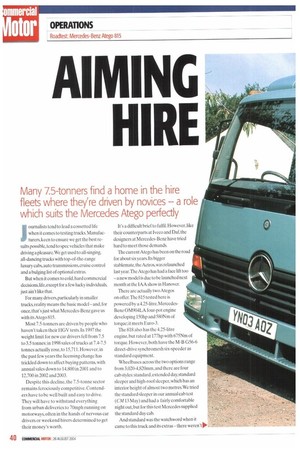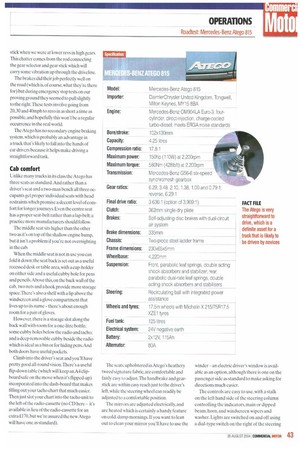Many 75-tonners find a home in the hire fleets where
Page 40

Page 42

Page 43

If you've noticed an error in this article please click here to report it so we can fix it.
they're driven by novices — a role which suits the Mercedes Atego perfectly
IIournalists tend to lead a cossetted life when it comes to testing trucks Manufacturers,keen to ensure we get the best results possible, tend to spec vehicles that make driving a pleasure. We get used to all-singing, all-dancing trucks with top-of-the-range luxury cabs, auto transmissions, cruise control and a bulging list of optional extras But when it comes to cold,hard commercial decisions, life, except for a few lucky individuals, just ain't like that.
For many drivers, particularly in smaller trucks, reality means the basic model— and,for once, that's just what Mercedes-Benz gave us with its Atego 815.
Most 7.5-tonners are driven by people who haven't taken their 110V tests, In 1997 the weight limit for new car drivers fell from 7.5 to 3.5 tonnes: in 1998 sales of trucks at 7.4-7.5 tonnes actually rose, to 15,711. However, in the past few years the licensing change has trickled down to affect buying patterns, with annual sales down to 14,800 in 2001 and to 12,700 in 2002 and 2003.
Despite this decline, the 7.5-tonne sector remains ferociously competitive. Contenders have to be well built and easy to drive. They will have to withstand everything from urban deliveries to 70inph running on motorways, often in the hands of nervous car drivers or weekend hirers determined to get their money's worth. It's a difficult brief to fulfil. However, like their counterparts at lveco and Daf, the designers at Mercedes-Benz have tried hard to meet those demands.
The current Atego has been on the road for about six years Its bigger stablemate, the Actros, was relaunched last year.The Atego has had a face lift too —a new model is due to be launched next month at the IAA show in Hanover.
There are actually two Ategos on offer.The 815 tested here is powered by a 4.25-litre, MercedesBenz 0M904LA four-pot engine developing 150hp and 580Nm of torque;it meets Euro-3.
The 818 also has the 4.25-litre engine, but rated at 177hp with 675Nm of torque. However, both have the M-B G56-6 direct-drive synchromesh six-speeder as standard equipment.
Wheelbases across the two options range from 3.020-4,820mm, and there are four cab styles: standard, extended day, standard sleeper and high-roof sleeper, which has an interior height of almost two metres. We tried the standard sleeper in our annual cab test (CM 13 May) and had a fairly comfortable night out, but for this test Mercedes supplied the standard day cab.
And standard was the watchword when it came to this truck and its extras— there weren't any. Merc purposely specced this test truck to match what operators are buying in the real world,so we got no extras apart from a welladjusted Ecotec air kit to help air flow round the Chambers Engineering box body.
Productivity
The last time we tested anAtego, the fuel result was startling— but only because it was so much poorer than we had expected, turning in an average of only 13mpg. In mitigation, we were landed with a tall 22ft long curtainsider whose curtains were sucked in by about 150mm all the way round the route: hardly conducive to good fuel economy. Windy gusts round the route didn't help much either.
This time round the weather was better, with only a stiff breeze to plough through on the M4 section, which eased off as our test progressed. We were expecting something better than 13mpg and certainly managed that, with an overall fuel figure of 17.9mpg. Splitting the route up, we recorded 18.7mpg on A-roads, and 16.5mpg on the motorways.
That motorway figure is worse than the 17.2mpg achieved by the Daf LF45, although we were bowling along more than 2km/h faster — the Atego easily maintained 70mph. The only things we had to slow down for were the Severn Bridge toll and a stretch of motorway just after Swindon where an Army truck appeared to have shed a load of gas tanks on the verge and adjoining fields,but we were soon back up to our 70mph target.
The Daf LF45 holds the fuel economy record for 7.5-tonners on our route, and beating it was never going to be easy. But the Atego's results were still good—good enough to beat the Daewoo Avia and Mitsubishi Canter. So fuel economy is good, but what about payload? At 4.12 tonnes it's the lowest in our comparison group, being beaten by the Daf, the Daewoo and the Mitsubishi . In fact the Atego's payload is 300kg below the best in class, although employing a canny bodybuilder would probably reduce that figure. Mercedes would doubtless claim that its contender is heavier because it's better screwed together than some of the competition and will last longer.
On the road
The Atego is nothing if not keen. While it has the same horsepower as the LF45, it provides a useful 30Nm more torque and has plenty of gumption.
With a 3.63:1 back axle we did find that on the motorway most of our time at 70mph was spent in the orange band, which can't have been particularly helpful in terms of fuel consumption. Even so, it would have gone faster. We didn't lose much speed on the motorway run, and it was relatively easy to keep it at the 70mph limit.
We dropped into sixth after Newbury and didn't have to touch the gearstick until the Severn Crossing. There's no cruise control but we didn't find it difficult to keep the Atego at the required speed throughout the test — as confirmed by our average speed of 70.6km/h.
This truck is capable of digging deep for power, managing to restart on the 33% (1-in-3) proving ground test hill without too much effort —its handbrake also held the truck steady on that gradient. On the twisty uphill stretch after turning off the A449 towards Hereford we managed to make it to the top in fourth gear at 850ipm! The engine seems well suited to lugging down on the hills, which can only enhance the Atego's driveability.
As well as storming up hills the Atego's acceleration on the flat beat the competition at all speeds. This is partly explained by its relatively low gearing: we reached each gear's top speed more quickly than we expected, before the engine sounded strained.That's probably a good thing where 7.5-tonners are concerned— this is classic rental fleet country and the gearing should stop would-be truck racers inflicting too much damage to the driveline.
In fact we spent most of our time in top gear as the engine was flexible enough to pick up again after slowing down without having to change gear. Overall, we found the gearbox straightforward to use, but other drivers have found the wide spacing between gates takes a bit of getting used to, and it is quite a long throw to first,third and fifth gears.
Hire fleet operators will be pleased to hear that the Atego is very easy to drive, even for novices. It tracks well round corners, doesn't roll too much round sharp bends, and is generally well mannered. Steering is precise, and although it does sound a touch agricultural from the outside, inside, it's fine, although slightly noisier than the Daf LF45.We did note a little vibration coming up through the gear stick when we were at lower revs in high gears. This chatter comes from the rod connecting the gear selector and gear stick which will cart), some vibration up through the driveline.
The brakes did their job perfectly well on the road (which is, of course, what they're there for) but during emergency stop tests on our proving ground they seemed to pull slightly to the right.These tests involve going from 20,30 and 40mph to zero in as short a time as possible, and hopefully this won't be a regular occurrence in the real world.
The Atego has no secondary engine braking system, which is probably an advantage in a truck that's likely to fall into the hands of car drivers because it helps make driving a straightforward task.
Cab comfort Unlike many trucks in its class the Atego has three seats as standard.Ancl rather than a driver's seat and a two-man bench all three occupants get proper individual seats with head restraints which promise a decent level of comfort for longer journeys. Even the centre seat has a proper seat-belt rather than a lap-belt:a practice more manufacturers should follow.
The middle seat sits higher than the other two as it's on top of the shallow engine hump. but it isn't a problem if you're not overnighting in the cab.
When the middle seat is not in use you can fold it down; the seat back is set out as a useful recessed desk or table area, with a cup-holder on either side and a useful cubby hole for pens and pencils. Above this, on the back wall of the cab, two nets and a hook provide more storage space.There's also a shelf with a lip above the windscreen and a glove compartment that lives up to its name—there's about enough room for a pair of gloves.
However, there is a storage slot along the back wall with room for a one-litre bottle; some cubby holes below the radio and tacho; and a deep removable cubby beside the radio which is ideal as a bin or for hiding pens. And both doors have useful pockets.
Climb into the driver's seat and you'll have pretty good all-round vision.There's a useful flip-down table (which will keep an A4 clipboard safe on the move when it's flipped-up) incorporated into the dash-board that makes filling out your tacho chart that much easier. Then just slot your chart into the tacho unit to the left of the radio-cassette (no CD here— it's available in lieu of the radio-cassette for an extra £170, but we're assured the new Atego will have one as standard). The seats, upholstered inAtego's heathery tweed signature fabric, are comfortable and fairly easy to adjust.The handbrake and gearstick are within easy reach just to the driver's left, while the steering wheel can readily be adjusted to a comfortable position.
The mirrors are adjusted electrically, and are heated which is certainly a handy feature on cold, damp mornings. If you want to lean out to clean your mirror you'll have to use the winder—an electric driver's window is available as an option, although there is one on the passenger side as standard to make asking for directions much easier.
The controls are easy to use, with a stalk on the left hand side of the steering column controlling the indicators, main or dipped beam, horn, and windscreen wipers and washer. Lights are switched on and off using a dial-type switch on the right of the steering


























































































































































































